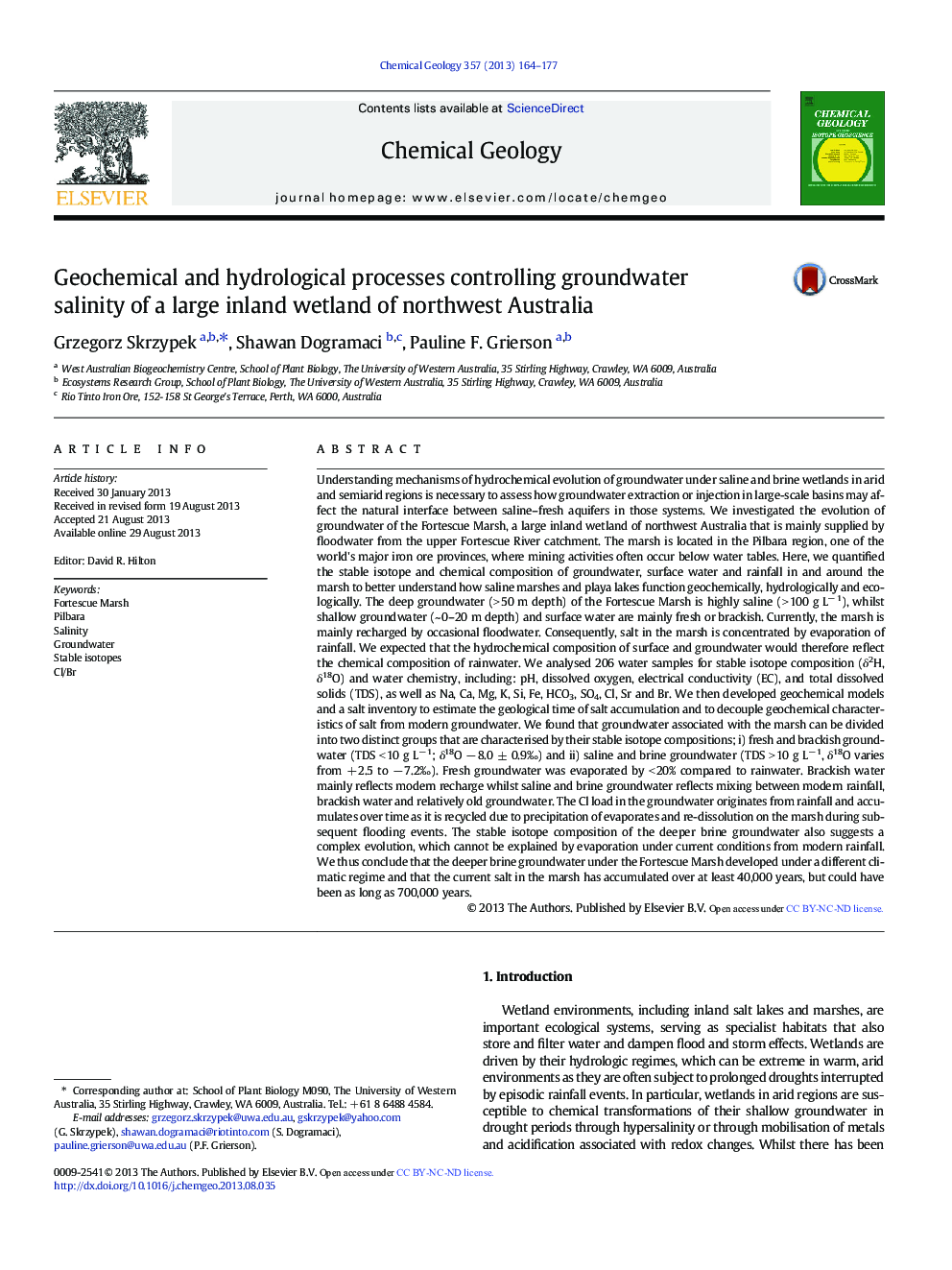| کد مقاله | کد نشریه | سال انتشار | مقاله انگلیسی | نسخه تمام متن |
|---|---|---|---|---|
| 6436878 | 1637612 | 2013 | 14 صفحه PDF | دانلود رایگان |
- Fresh & brackish groundwater (FBG) δ18O is â 8.0 ± 0.9â°.
- Saline & brine groundwater (SBG) δ18O is 2.5 to â 7.2â°.
- FBG was <Â 20% evaporated compared to rainwater and reflects modern recharge.
- SBG reflects mixing of modern rainfall and brackish water.
- Cl load originates from rainfall and accumulates over 40,000-700,000Â years.
Understanding mechanisms of hydrochemical evolution of groundwater under saline and brine wetlands in arid and semiarid regions is necessary to assess how groundwater extraction or injection in large-scale basins may affect the natural interface between saline-fresh aquifers in those systems. We investigated the evolution of groundwater of the Fortescue Marsh, a large inland wetland of northwest Australia that is mainly supplied by floodwater from the upper Fortescue River catchment. The marsh is located in the Pilbara region, one of the world's major iron ore provinces, where mining activities often occur below water tables. Here, we quantified the stable isotope and chemical composition of groundwater, surface water and rainfall in and around the marsh to better understand how saline marshes and playa lakes function geochemically, hydrologically and ecologically. The deep groundwater (> 50 m depth) of the Fortescue Marsh is highly saline (> 100 g Lâ 1), whilst shallow groundwater (~ 0-20 m depth) and surface water are mainly fresh or brackish. Currently, the marsh is mainly recharged by occasional floodwater. Consequently, salt in the marsh is concentrated by evaporation of rainfall. We expected that the hydrochemical composition of surface and groundwater would therefore reflect the chemical composition of rainwater. We analysed 206 water samples for stable isotope composition (δ2H, δ18O) and water chemistry, including: pH, dissolved oxygen, electrical conductivity (EC), and total dissolved solids (TDS), as well as Na, Ca, Mg, K, Si, Fe, HCO3, SO4, Cl, Sr and Br. We then developed geochemical models and a salt inventory to estimate the geological time of salt accumulation and to decouple geochemical characteristics of salt from modern groundwater. We found that groundwater associated with the marsh can be divided into two distinct groups that are characterised by their stable isotope compositions; i) fresh and brackish groundwater (TDS < 10 g Lâ 1; δ18O â 8.0 ± 0.9â°) and ii) saline and brine groundwater (TDS > 10 g Lâ 1, δ18O varies from + 2.5 to â 7.2â°). Fresh groundwater was evaporated by < 20% compared to rainwater. Brackish water mainly reflects modern recharge whilst saline and brine groundwater reflects mixing between modern rainfall, brackish water and relatively old groundwater. The Cl load in the groundwater originates from rainfall and accumulates over time as it is recycled due to precipitation of evaporates and re-dissolution on the marsh during subsequent flooding events. The stable isotope composition of the deeper brine groundwater also suggests a complex evolution, which cannot be explained by evaporation under current conditions from modern rainfall. We thus conclude that the deeper brine groundwater under the Fortescue Marsh developed under a different climatic regime and that the current salt in the marsh has accumulated over at least 40,000 years, but could have been as long as 700,000 years.
Journal: Chemical Geology - Volume 357, 24 October 2013, Pages 164-177
